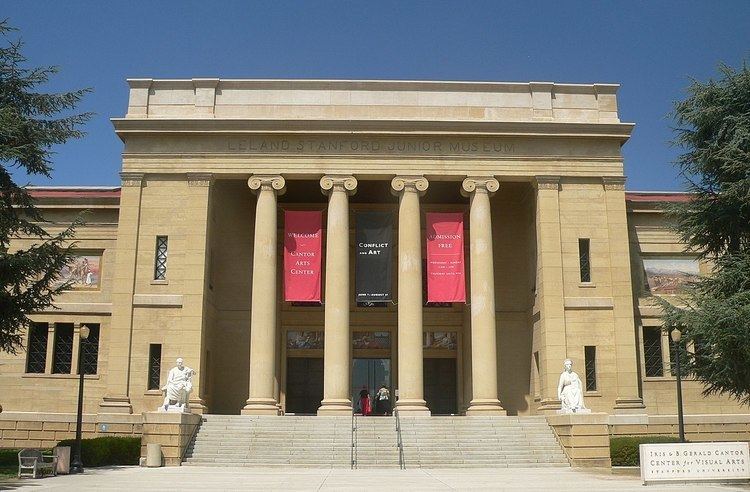Established 1894 Type Art museum Elevation 23 m Founded 1894 | Location Stanford, California Founder The Stanford family Phone +1 650-723-4177 Artwork The Three Shades | |
 | ||
Former name Stanford University Museum of Art Key holdings Auguste Rodin sculptures Address 328 Lomita Dr, Stanford, CA 94305, USA Hours Open today · 11AM–5PMWednesday11AM–5PMThursday11AM–8PMFriday11AM–5PMSaturday11AM–5PMSunday11AM–5PMMonday11AM–5PMTuesdayClosed Similar Hoover Tower, Anderson Collection at Stanfor, Stanford Memorial Church, Stanford Shopping Center, Palo Alto Junior Museum | ||
The Iris & B. Gerald Cantor Center for Visual Arts at Stanford University, formerly the Stanford University Museum of Art, and commonly known as the Cantor Arts Center, is an art museum on the campus of Stanford University in Stanford, California. The museum, which opened in 1894, consists of over 130,000 square feet of space, including sculpture gardens. The Cantor Center houses one of the largest collections of Auguste Rodin sculptures, with 199 works by Rodin, most in bronze but also other media; many sculptures are on display in the B. Gerald Cantor Rodin Sculpture Garden.
Contents
History
The Leland Stanford Jr. Museum opened in 1894, one of the few museums founded by a private family with a general art collection. By 1905, the museum was known for its collection of Asian art. The 1906 San Francisco earthquake leveled two wings of the building, destroying the Roman, Egyptian and Asian galleries. Three-quarters of the building were damaged beyond repair. The earthquake, coupled with the death of co-founder Jane Stanford, affected the museum's budget. The museum did not have its own endowment outside of the University, and faculty and administration were focused on academic concerns after the earthquake. The building fell into disrepair and curatorial duties eventually stopped.
Between 1917 and 1945 Pedro Joseph de Lemos, the former head of the San Francisco Art Institute, held the posts of Curator and Director of the Stanford University Museum as well as the Thomas Welton Stanford Art Gallery. He completely reorganized the museum and began a regular series of exhibitions at both venues. According to the Daily Palo Alto Times de Lemos maintained the museum “as a working unit of the University itself . . . with collections that can be consulted with educational benefit to the students.” Part of the museum's space was used by natural science departments before closing in 1945. The museum's collection was inventoried and works of less interest and "aesthetic merit" were deaccessioned. a number of the original works from the Stanford family collection were deaccessioned due to the aesthetic taste of the 1950s. In May 1951, 2,000 visitors were welcomed into the museum for a two-day trial visit. This allowed the museum to examine if community interest was high enough to justify reopening the museum. In 1953, the Committee for Art at Stanford was founded, with the intention of recruiting members and raising funds to re-open the museum. for the next 24 years, the museum worked to expand and conserve its collection, and develop programming, educational services and publications.
In 1985, professor Albert Elsen worked with art collector B. Gerald Cantor and other donors, to open the B. Gerald Cantor Rodin Sculpture Garden. In 1989, the museum suffered another earthquake, the Loma Prieta which caused severe damage and forced the museum to close. Stanford hired Thomas K. Seligman, in 1991, to direct the rebuilding of the museum. Seligman plan was to redefine the museum as an arts center, stressing the institution's opportunity to educate Stanford's students, school children and the wider public. The museum reopened in 1999 as the Iris & Gerald Cantor Center for the Visual Arts and in July 2005, the museum had its one millionth visitor.
Connie Wolf was director of the Cantor museum from 2012 to 2016.
Renovations and re-opening
After being heavily damaged by the Loma Prieta earthquake in 1989, the building underwent major renovations and construction before reopening as the Cantor Center for Visual Arts. The Center was designed by the architectural firm Ennead Architects. The project cost $36.8 million, which included a seismic upgrade of the entire 78,000 square foot historical building and the new 42,000 square foot wing. The Rodin Sculpture Garden was improved, and new gardens were installed for contemporary works. The new wing added an additional 12,000 square feet of exhibition space for modern and contemporary collections. Contemporary architecture is blended with the original 1891 building, with a full-length glass wall, which looks over the courtyard between the new and old buildings.
Collection
The Cantor Center Visual Arts collection is encyclopedic in nature, including antiquity, ethnographic art, modern, contemporary. The center houses over 500 works of African art, with a focus on figurative art from Sub-Saharan Africa. About 70 works of this collection are on exhibit. The Center's Oceanic and Indonesian collections consist of over 450 objects and textiles, including works from the Batak. Native American art collections focus mainly on California, Southwest and Northwestern works. Basketry and cultural objects from the Yurok, Karuk, and Hupa peoples, as collected by John Daggett are on display, and are from the original museum collection. About 200 works from Mesoamerica are also on display, including terracotta works from West Mexico and ancient ceramics from the Mimbres, the Anasazi and Casas Grandes.
The Center has the largest collection of Auguste Rodin works outside of the Musee Rodin in Paris. The collection, purchased by B. Gerald Cantor, includes over 400 works.
In 2011, the University announced the donation of 121 paintings and sculptures from Harry W. and Mary Margaret Anderson, and their daughter, Mary Patricia Anderson Pence, of Atherton, California. The collection, mostly of post-WW2 American art, includes Jackson Pollock's Lucifer as well as works from Mark Rothko, Ad Reinhardt and Willem de Kooning. A gallery devoted to the collection opened in 2014 as a separate museum named the Anderson Collection which is located next to the Iris & B. Gerald Cantor Center for Visual Arts building on the Stanford University campus.
